Room acoustics
The experiments are carried out in our (me and Christine) living room. Luc, my cousin double-checks the observations in his living room, which has a different shape and setup. The following plan gives an idea of our living room. The height of the room is 2.50m (for non-ISO people, 1 meter equals 39.37 inch, or 1 inch equals 2.54cm).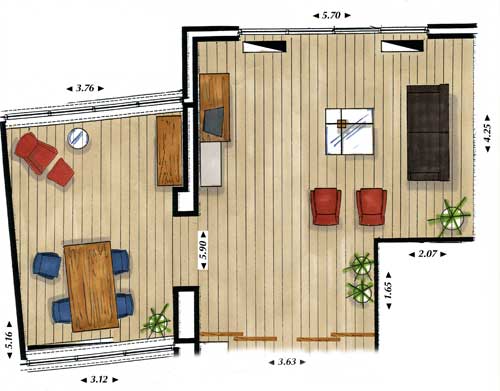
For European standards the size of the room is moderate to large. We like a "simplistic" style, so there is not so much furniture in the house. All furniture is "low", so above say 1m there is no furniture. Around the listening position, there is a carpet on the floor, that provides quite some dampening. Closing the curtains is reduces reflections a lot, and for serious listening this is a must-do. The kitchen is separated by a (own designed) sliding wall, which also reduces reflections significantly.
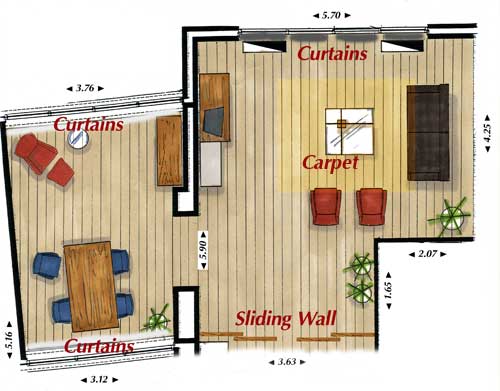
For an impression, I've enclosed some (non-recent) pictures:
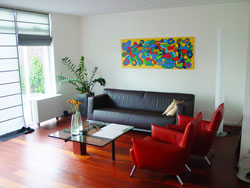
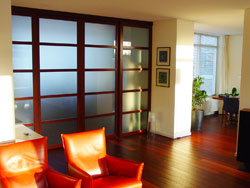


In short, the acoustics of this place are not so good. This is also apparent when discussing with a group of people. This sounds "stressful", with not "rest" in the sound. Closing the curtains helps a lot, but during daytime is a bit silly to do. The overall sound timbre of the place is on the harsh side. As your speakers will never sound better than the room they are in, I know I have to compensate my listening experience. I've heavily experimented with different speaker setups in the living room. I've summarized my observations below.
Position 1, against the wall

The initial setup of the speakers is the most WAF-compliant one (speakers yellow dots, listener blue dot). I agree with Christine here, the best place of speakers and audio is out of sight. Unfortunately, if you want speakers like this to come to their full potential, concessions need to be made.
As can be expected, this is not a good place for speakers to be (see Jon's explanation, refering to Cardas's setup guide; unfortenately I have no rectangular room). The bass becomes prominent and boomy and woofy. All sound seems to be distant and far away, there is no forward presentation. Also pinpointing of sound sources becomes difficult, the sources seem to smear from left-to-right. This is confirmed by test CD 13, PART3, where the spatial checks show big artifacts.
Postition 2, 0.8 meter in front of the wall
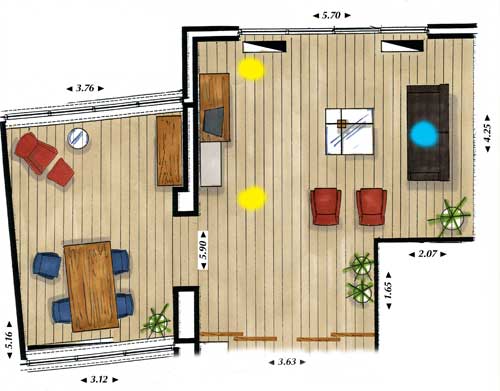
Fortunately, I've applied felt underneath the speakers, so they can be moved within a few seconds on our wooden floor. Moving the speakers forward with roughly 1 meter, improves the spatial image considerably. The feeling of everything being distant and far away is gone. The bass performance remains poor though, and the forward presentation is still limited.
Postion 3, 2 meter in front of the wall
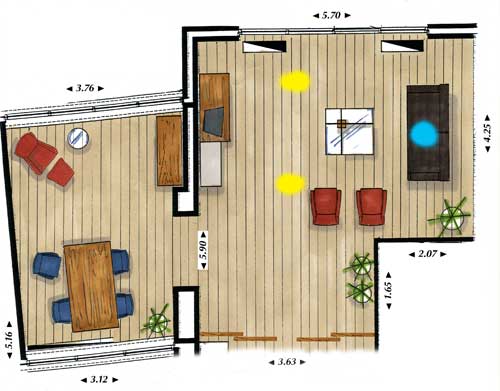
A position I use often. This position comes most close to the "golden ratio" setting, as described by Cardas. In my case this would mean RW=4.25m, hence 1.9m from the rear wall, 1.2m from the side walls.
This setting is on the bass-heavy side, but still provides the best integrated timbre of all the positions I've tried. It provides a very homogeneous and forward sound, with a lot of push in the low and mid, and a vivid, bright, but never brittle treble. The minus side is somewhat lack of "air around" the sound sources (improving when moving the head a bit forward), a less deep spatial image (also improving when moving the head a bit forward), and an extremely high sensitivity of the listening position towards pinpointing, where a slight off-set of the head to the left needs to be made. I guess this is related to the different nature and amount of reflections. The Thiel units have a very wide radiation pattern, and my experience is that they are very sensitive towards reflections. The timbre is also very sensitive to movement of the head. If the speakers are this close-by, they only seem to require a very small tilt towards the user. This preserves a wide spatial image for orchestras, and needle-sharp pin-pointing of lead singers.
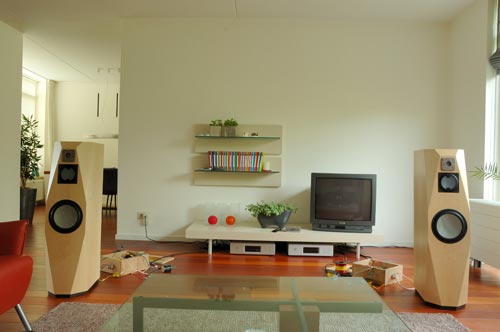
Position 4, next to the couch
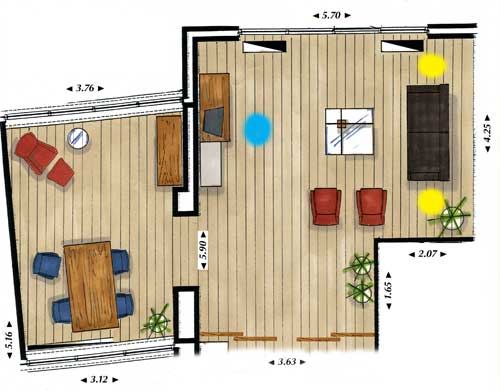
Forget about this one. Boomy bass, fuzzy spatial image. A very full timbre.
Position 5, just in front of the heating radiators
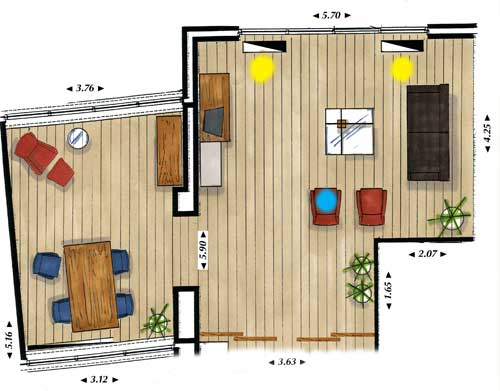
This position offers "air around" the instruments. The spatial image is very open, and all sound sources have their own position. Downsides are a bit "clean" timbre (lack of bass at the listening position, if you stand 1 meter beyond the chair it the bass is much stronger), treble integrates difficult with mid (doesn't seem capable to get a metallic edge to cymbals unless introducing sibilance), and there is a slight offset to the right regarding positioning in the spatial field. The spatial image also lacks depth. Eelco's test CD, where there is a track where a speakers should be in between the left and the middle, fails, whereas for the right speaker it works. But the biggest issue is some humming in the 100Hz range, that reveals itself at the E-pitch of voice, guitar and piano.
I have a picture of this setup ( a bit shifted to the left) when we were heavily experimenting with crossover filters.
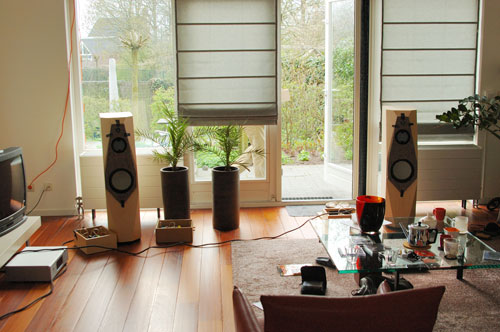
Position 6, before the sliding wall
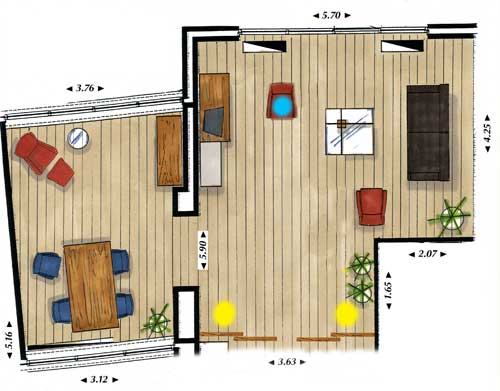
Too much bass, besides some advantages that are even much better at position 7.
Position 7, 1.5 meter in front of the sliding wall

Considering spatial field, and air around the instruments, this is supreme! You're sitting with the jazz band, inside the concert hall, etc. Very very realistic, as if you can touch the scene. Especially when the sliders of our sliding wall are opened. This positions however also suffers from the humming problem, as encountered with position 5 and 6. Still too much bass as well.
Reflections
The living room has quite some reflections. One nice way to make this audible, is to compare the anechoic measurement of the speaker with the measurement of the speaker in the living room. In both cases, a frequency sweep has been measured, and converted to an impulse response by using an inverse FFT. In a next step, I've exported the impulse response to a wav file, and for reasons of size converted it to an mp3 file. A sound file says more than a thousand of waterfall diagrams: anechoic impulse response versus impulse response in living roomConclusions
There is no clear "winner" here. Position 5 and 7 are the best ones, and have their own plus and minus. For filter tweaking I suspect position 7 is better, because position 5 seems to be more forgiving about artifacts. For practical reasons, position 1 will be the default "background music" position. For short-term listening, it is easy to move the speakers towards position 5. My overall preference is for position 5.I guess that both the speakers as well as the listener should be free from the walls. The wall of the hall (the square part of 2.07 x 1.65), and depending on the situation the wall of 4.25m are the big problems with reflections. I'm not an acoustics engineer, but I guess there are some simple means to improve on things (book shelves, clothing, etc.). To be continued!!!
Links
Some info about room acoustics can be found at:- audioholics
Acoustic treatments
Some companies that sell acoustical treatments:- Mavotrans
- Akma
next ->